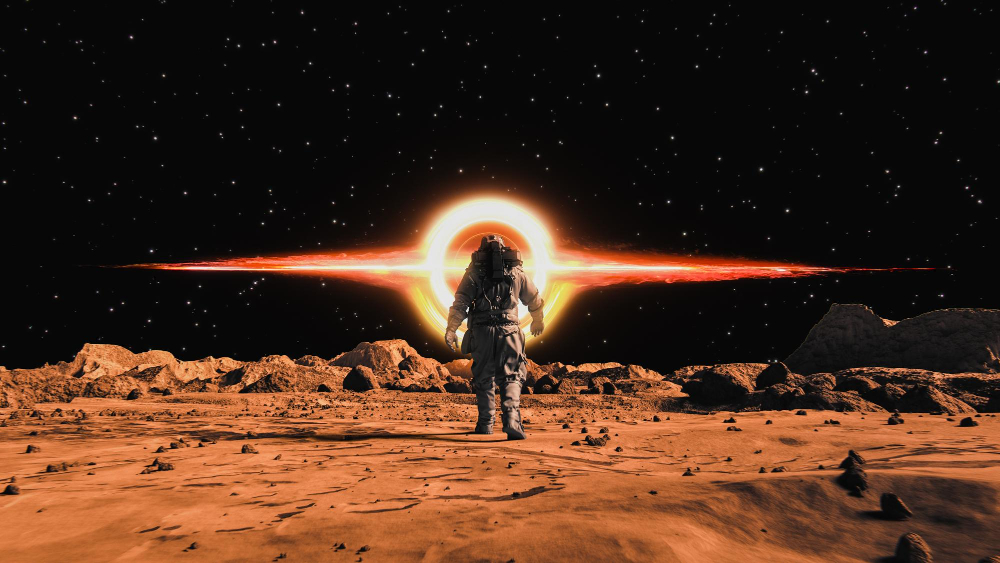Since its release in 2014, Christopher Nolan’s epic space odyssey “Interstellar” has captivated audiences worldwide with its breathtaking visuals, thought-provoking narrative, and scientific concepts that push the boundaries of our understanding of reality. This article delves into the intriguing connection between “Interstellar” and the realm of reality, examining the scientific foundations behind the film’s core concepts and exploring the extent to which they align with our current knowledge.
Interstellar was re-released again in july 2023 before the screening of Oppenheimer movie.
Wormholes and Time Dilation:
At the heart of “Interstellar” lies the concept of traversing vast distances in space through wormholes—a theoretical shortcut through the fabric of the universe. While wormholes remain purely hypothetical in reality, their existence is grounded in scientific theory, allowing for fascinating speculation on their potential properties and applications. The film portrays the protagonists utilizing a wormhole near Saturn to reach another galaxy, thereby enabling interstellar travel. While this specific implementation may be fictional, the idea of utilizing wormholes as interstellar gateways is rooted in scientific inquiry.
Moreover, “Interstellar” brilliantly explores the effects of time dilation, where time passes at different rates depending on gravity’s strength. This concept, supported by Einstein’s general theory of relativity, is demonstrated through the film’s powerful depiction of the characters experiencing drastically different timelines as they explore distant planets near a massive black hole.
Black Holes and Singularity:
The film delves into the enigmatic nature of black holes, showcasing the mesmerizing visual representation of a supermassive black hole named Gargantua. Through meticulous research and collaboration with renowned astrophysicists, the film presents a plausible depiction of the gravitational lensing and time dilation effects caused by the intense gravitational pull of a black hole.
Furthermore, “Interstellar” delves into the realm of singularity, where space and time become infinitely warped. While our understanding of singularity remains limited, the film takes artistic liberties to explore the possibilities of manipulating the fabric of reality near the event horizon of a black hole—a notion that sparks the imagination and invites philosophical questions.
Environmental Crisis and Humanity’s Fate:
Beyond its scientific elements, “Interstellar” paints a poignant portrait of a dystopian Earth facing an impending environmental catastrophe. As the characters embark on their interstellar voyage, the film draws attention to the fragility of our planet and the potential consequences of neglecting environmental stewardship. While the specifics of the portrayed crisis may be speculative, it serves as a stark reminder of the importance of sustainable practices and the potential consequences of our actions on Earth’s future.
Interstellar Black hole vs real Blackhole:
“Interstellar” is renowned for its stunning and scientifically accurate representation of a black hole, particularly the supermassive black hole Gargantua. The visual effects team worked closely with renowned astrophysicist Kip Thorne to ensure the depiction was as realistic as possible. By accurately portraying the gravitational lensing and light-bending effects around the black hole, the film offered audiences a breathtaking and immersive experience.

James Webb Space Telescope captured image of blackhole in July 2022, Which shown the blackhole’s side another view, and it was pretty much similar to what shown in the movie. Light is bended due to huge amount of gravity, also we can see the outer layer of blackhole ring.

“Interstellar” masterfully weaves together elements of science, speculation, and human emotion, creating an awe-inspiring cinematic experience. While some aspects of the film take creative liberties and venture into the realm of science fiction, it remains firmly rooted in scientific concepts and theories that are the subject of ongoing exploration and study.
By blending imagination with scientific plausibility, “Interstellar” sparks conversations and encourages viewers to reflect on the nature of reality, the mysteries of the universe, and our place within it. Whether through its depiction of wormholes, black holes, or the existential challenges facing humanity, the film serves as a testament to the power of storytelling in exploring the boundaries of our understanding of reality and the profound questions that lie beyond.
As we continue to explore the cosmos and expand our knowledge of the universe, films like “Interstellar” remind us of the wonders that await and the intricate relationship between science, imagination, and the eternal quest for truth.
Keep smiling 🙂
